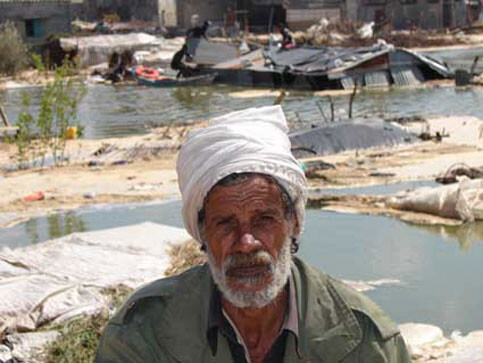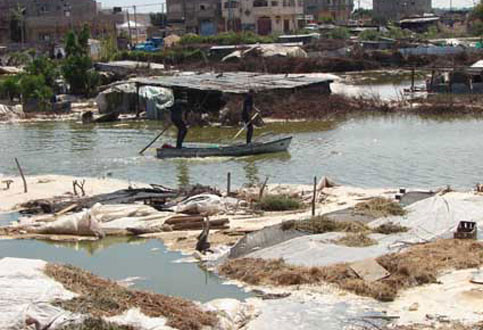Palestinian Center for Human Rights 27 March 2007

At approximately 10:00 on Tuesday, 27 March 2007, four Palestinians, an elderly woman and 3 children, were killed and 20 others injured in the Um El-Naser (Bedouin) village, when the earth barriers around a sewage disposal pool broke 150 meters to the north of the village. As a result, sewage water flooded from the pool flooded the village, and the effect was more devastating due to the fact that the pool’s elevation was higher than the village, giving the flood more power and destructive force. The level of sewage water was 2 meters high in the village. Four people were drowned to death, and 20 others were injured by the flooding. Emergency crews from the Civil Defense Corps, Medical Crews, and Naval Police were still trying to find missing people at the time of publication. More than 250 homes were damaged, including 20 homes that were totally destroyed. In addition, substantial damage was caused to commercial shops, private vehicles, and other services in the area.
Medical sources in Kamal Odwan Hospital in Beit Lahia, Shifa Hospital in Gaza, and the Medical Emergency Relief clinic in the village informed PCHR that they received the bodies of four dead victims, all of them residents of the Bedouin village: Nasra Nuseir Salem Ermeilat (70); Suheir Salab Abu Ghrara (17); Mohammad Salem Masek Abu Atieq (1); and Jamal Barak Abu Safra (3).
In addition, 20 injured people were rescued by emergency crews. Eight women were among the injured.

PCHR’s staff rushed to the area to assess the damage and size of the environmental disaster. The staff noted a state of mass migration by the residents of the stricken village. Residents informed PCHR’s staff that 4 people remain missing, including an elderly woman and a child. Rescue efforts continued at the time of publication.
It is noted that PCHR has warned of an environmental and humanitarian disaster in the area a long time ago. The Centre called upon responsible authorities, including Israeli Occupation Forces (IOF), to work to avert such a disaster a few years ago. In addition, the Centre warned against the contamination of underground water resources in the area by the sewage pools. In this context, the Centre reminds of the most notable elements of its position in the past:
In 1993, the Centre objected to IOF efforts forcibly transfer the civilian residents of the area, known then as Sa’ad El-Ansari area, and exerted all possible legal effort to stop the eviction. The Center’s efforts succeeded in keeping the residents in their homes.
At the end of 1997, the PNA evicted some residents from Sa’ad El-Ansari area to the area adjacent to the sewage disposal pools in the area. Today, the area is known as Um El-Naser Village. At the time, PCHR expressed serious concern over the lives of these civilians as a result of the health risks posed by these pools, including stench, insects, and contamination of underground water resources. The Centre also warned of the possibility of flooding.
The project of transferring these sewage pools to the east of Gaza City was delayed for more than two years due to delays in importing pipes and pumps from abroad as a result of the closure imposed by IOF on the Gaza Strip. In addition, IOF military operations in the project area prevented workers from free and safe access to the area to conduct their work. It is noted that this project is funded by the World Bank, European Commission, Sweden, and other donors.
On 14 September 2006, the Centre in its capacity as the legal representative of residents of Nada Housing Project in the area sent a complaint to Mr. Ismail Abu Shammala, Governor of the Northern Gaza Strip. The complaint demanded a cessation of diggings by the Palestinian Water Authority and Northern Gaza municipalities to dig a new sewage pool. The complaint made clear the health and environmental risks of the new pool on residents of the area. The Centre demanded that the Governor stop the digging as soon as possible. The Governor replied on 20 September 2006 and stated that he understands the scope and danger of the problem. However, he justified the implementation of the project by stating that there is a real danger of flooding in Um El-Naser Village and Mansheya area in Beit Lahia. He also stated that the new pool is temporary till the removal of the pits to the eastern part of the governorate in April 2007.
PCHR views the construction of a new sewage pool on an area of 20 dunums at a distance of 150 meters from Um El-Naser village as a factor that adds to the danger. In addition, the earth barriers built inside the pools to protect them do not provide the minimum safety requirement against high sewage water level in the new pool. Many area residents stated that since the construction of the new pool, the pumping of sewage to the new pool was conducted around the clock. Thus, it was only natural for sewage levels to rise and for the earth barriers to break, causing the disaster in the Um El-Naser (Bedouin) Village. It is strange that the responsible parties in the PNA dealt with the issue in a negligent manner, despite their full understanding of the situation and the imminent threat to the lives of civilians. The issue was not prioritized; and the safety of nearly 5,000 civilian residents of the village and thousands more in surrounding areas were not taken into serious consideration.
The pool that broke was the new pool that was completed nearly 6 months ago, after the old pools reached maximum capacity. It is noted that the pumping operation to the new pool was conducted under the supervision of a technical engineer.
All the reasons and elements above are behind the environmental disaster that hit Um El-Naser village. The victims’ information is preliminary. The Centre had forewarned of this disaster, and will work to public a detailed report on its investigation into the issue.
The Centre calls upon the PNA to open an immediate investigation into the disaster to determine the responsible parties that took the decision that did not provide the minimum safety requirements for the lives of civilians; the Centre demands the public disclosure of the findings in the media; The PNA to fulfill its responsibility and provide emergency assistance, including shelter, for more than 3,000 people uprooted as their homes were damaged; the PNA and International Community, including humanitarian organizations working in the OPT to provide the food, medication, clothing, and water needs for the uprooted families, and to provide medical crews to perform examinations on the affected civilians out of fear of contamination or injury by the sewage water; the International Community to exert immediate pressure on IOF to immediately allow the start of implementation of the project to transfer the sewage pools to the eastern part of the northern Gaza Strip, to ensure the safety of technical crews working on the project, and to refrain from firing munitions into the project area. The Centre calls upon the International Community to provide immediate emergency assistance, including medication, food, living essentials, and equipment that will help in finding the missing persons.
Related Links